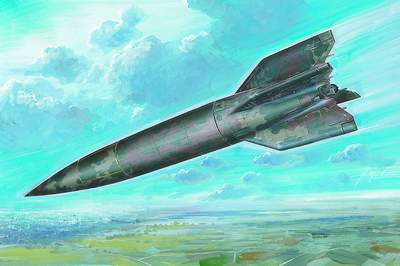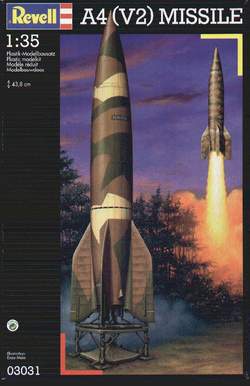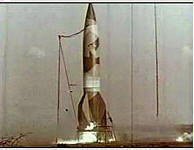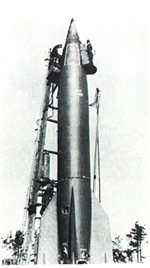Time Travel Research Center © 2005 Cetin BAL - GSM:+90 05366063183 - Turkey / Denizli
The V-2 (A4) Ballistic Missile Technology
 |
The V-2 was the first ballistic missile used in warfare and a significant advancement in rocket technology. Also known as the A4, it was developed by Nazi Germany during World War II and used against the Allies, primarily as a terror weapon. Because it was so inaccurate (it could barely hit a city-size target), it could not be used against specific military targets and was instead used against civilians who had no defense against it as it came screaming down from the upper atmosphere. Adolf Hitler named it his "Vengeance Weapon 2"or "V-2" because it wreaked vengeance upon a helpless population. (The "Vengeance Weapon 1," or "V-1", was a cruise missile.)
Despite its relative inaccuracy, the V-2 incorporated several major technological advances in rocketry. Its engine was 17 times more powerful than the largest rocket motor constructed up to that time; it flew at five times the speed of sound; and it could still fly relatively accurately to targets nearly 190 miles (306 kilometers) away.
Work began on the A4 in 1940 but proceeded slowly at first. The rocket team employed some of the best aerodynamicists in Germany, who conducted systematic tests on subscale models. In August 1941, Hitler ordered the completion of development of the A4 and the production of several hundred test and pre-production vehicles. Testing occurred during 1941, when tests of the large engine required for the rocket kept ending in explosions.
 The
A4 incorporated four major advances: its powerful engine, its aerodynamic
shape, its innovative guidance system, and its radio transmission system.
Together, these produced a terrifying weapon that ultimately had little
military value to the Germans.
The
A4 incorporated four major advances: its powerful engine, its aerodynamic
shape, its innovative guidance system, and its radio transmission system.
Together, these produced a terrifying weapon that ultimately had little
military value to the Germans.
The rocket engine was fueled by an alcohol and water combination, with liquid oxygen serving as an oxidizer that enabled the fuel to burn, just as oxygen enables wood to burn. The fuel and oxidizer were pumped into a main combustion chamber where they mixed and then ignited, producing 56,000 pounds (249,100 newtons) of thrust, which escaped out of the rocket nozzle at the tail of the vehicle.
The engine contained a number of key technological innovations that enabled it to achieve significantly higher thrust. First, it had a new type of fuel nozzle for injecting the watered alcohol into the engine. These nozzles sprayed the fuel out in a rotational pattern that caused it to atomize better (in other words, create very small fuel droplets that had more surface area, like the water coming out of a spray bottle) so that it mixed better with the oxidizer and therefore burned more efficiently.
A second innovation was the use of a pre-chamber system that mixed the propellant and oxidizer in small chambers above the main combustion chamber. This produced better mixing before burning and kept the flames farther from the nozzles, preventing heat damage to the nozzles.
A third innovation was the use of a shorter, rounder combustion chamber, which mixed the propellants better than an earlier design with a longer chamber. The final innovation was the rocket exhaust nozzle. Previous nozzles had a 10-12-degree angle of opening between the sides of the cone, resulting in a long, thin cone. But the A4 engine had a nozzle with an angle of 30 degrees. This reduced friction between the exhaust gases and the wall and also resulted in a shorter nozzle.
Because the rocket would travel so fastfaster than any other object at that timeits aerodynamic shape was very important, particularly the fins for controlling the rocket. But determining the proper shape was difficult because no wind tunnel existed at the time that could test objects at such high speeds. The Germans built a world-class aerodynamic institute at their rocket test center at Peenemünde, with several supersonic wind tunnels. These tunnels were not ready in time, however, and many of the key decisions concerning the A4's shape were made from educated guesses and confirmed later. For instance, the unusual rounded shape of the A4 (when compared with modern rockets) was due to the fact that it was based on the shape of a rifle bullet. Designers figured that since a rifle bullet flew through the air without tumbling, a rocket using the same shape would do the same.
 The
third primary technological advance of the A4 was in the area of guidance.
Early rockets had no guidance system at all and could be aimed only in a
general direction. Later, some simple guidance systems were adopted that
directed rockets to pitch over in flight to aim toward a target. But the A4
had to fly a long distance with some degree of accuracy to hit its target,
so it required a system for pointing it in the right direction and shutting
off the engine once the proper velocity was achieved. This was achieved
through the use of what is called an
inertial guidance system, a system in which a stabilized platform
remains fixed in space regardless of how the vehicle moves around it. This
stabilized platform allows for measuring the position or acceleration of the
vehicle, since the platform remains pointed in one direction and the changes
in the vehicle can be measured compared to the stable platform. In the
middle of the rocket exhaust were four vanes that were used to deflect the
thrust and steer the rocket based upon commands from the guidance unit. The
A4 system was significantly more advanced than previous guidance systems.
Still, despite this advanced system, the A4 could hit only a city-sized
target from 190 miles (306 kilometers) away.
The
third primary technological advance of the A4 was in the area of guidance.
Early rockets had no guidance system at all and could be aimed only in a
general direction. Later, some simple guidance systems were adopted that
directed rockets to pitch over in flight to aim toward a target. But the A4
had to fly a long distance with some degree of accuracy to hit its target,
so it required a system for pointing it in the right direction and shutting
off the engine once the proper velocity was achieved. This was achieved
through the use of what is called an
inertial guidance system, a system in which a stabilized platform
remains fixed in space regardless of how the vehicle moves around it. This
stabilized platform allows for measuring the position or acceleration of the
vehicle, since the platform remains pointed in one direction and the changes
in the vehicle can be measured compared to the stable platform. In the
middle of the rocket exhaust were four vanes that were used to deflect the
thrust and steer the rocket based upon commands from the guidance unit. The
A4 system was significantly more advanced than previous guidance systems.
Still, despite this advanced system, the A4 could hit only a city-sized
target from 190 miles (306 kilometers) away.
 A
fourth advance was the development of a radio transmission system that could
relay information about the missile's performance to the ground. Earlier
test missiles used a movie camera to record an oscilloscope, which was a
device that projected a wave on a screen indicating the rocket's performance.
The film was then retrieved when the rocket splashed down. But because the
A4 test flights would cover hundreds of miles and recovery was nearly
impossible, the engineers needed a means of "tele-metering" information to a
ground station. This development, now referred to as telemetry, became
common to all rocket test programs, as well as to many aircraft test
programs.
A
fourth advance was the development of a radio transmission system that could
relay information about the missile's performance to the ground. Earlier
test missiles used a movie camera to record an oscilloscope, which was a
device that projected a wave on a screen indicating the rocket's performance.
The film was then retrieved when the rocket splashed down. But because the
A4 test flights would cover hundreds of miles and recovery was nearly
impossible, the engineers needed a means of "tele-metering" information to a
ground station. This development, now referred to as telemetry, became
common to all rocket test programs, as well as to many aircraft test
programs.
The A4 was 46 feet (14 meters) long and five feet (1.5 meters) in diameter at its thickest spot. Its fins spanned nearly 12 feet (3.7 meters) at the base of the rocket, and it weighed 45,000 pounds (20,412 kilograms). It had a 2,000-pound (907-kilogram) warhead that stayed attached to the rocket throughout flight, and the entire missile crashed down on its target. Its first successful flight was on October 3, 1942.
Thousands of A4/V-2 rockets were fired during the war. After the war ended, many members of the rocket team that developed the A4, including Wernher von Braun, went to the United States or the Soviet Union and assisted in the development of these countries' ballistic missile programs.
--Dwayne A. Day
Sources and Further Reading:
Hölsken Dieter. V-Missiles of the Third Reich, The V-1 and V-2. Hong Kong: Monogram Aviation Publications, 1994.
Johnson, David. V-1, V-2: Hitler's Vengeance on London. Chelsea, Mich.: Scarborough House, 1991.
Longmate, Norman. Hitler's Rockets: the Story of the V-2s. London: Hutchinson, 1985.
Neufeld, Michael, The Rocket and the Reich. New York: The Free Press, 1995.
Winter, Frank H. Rockets Into Space. Cambridge, Mass.: Harvard University Press, 1990.
On-Line References:
"The Evolution of the Rocket." http://www-istp.gsfc.nasa.gov/stargaze/Srockhis.htm
"V-2 Rocket." White Sands Missile Range. Public Affairs Office. http://www.wsmr.army.mil/paopage/Pages/V-2.htm
Alıntı: http://www.centennialofflight.gov/essay/Evolution_of_Technology/V-2/Tech26.htm
H
içbir yazı/ resim izinsiz olarak kullanılamaz!! Telif hakları uyarınca bu bir suçtur..! Tüm hakları Çetin BAL' a aittir. Kaynak gösterilmek şartıyla siteden alıntı yapılabilir.The Time Machine Project © 2005 Cetin BAL - GSM:+90 05366063183 -Turkiye/Denizli
Ana Sayfa /index /Roket bilimi /![]() E-Mail /CetinBAL/Quantum Teleportation-2
E-Mail /CetinBAL/Quantum Teleportation-2
Time Travel Technology /Ziyaretçi Defteri /UFO Technology/Duyuru